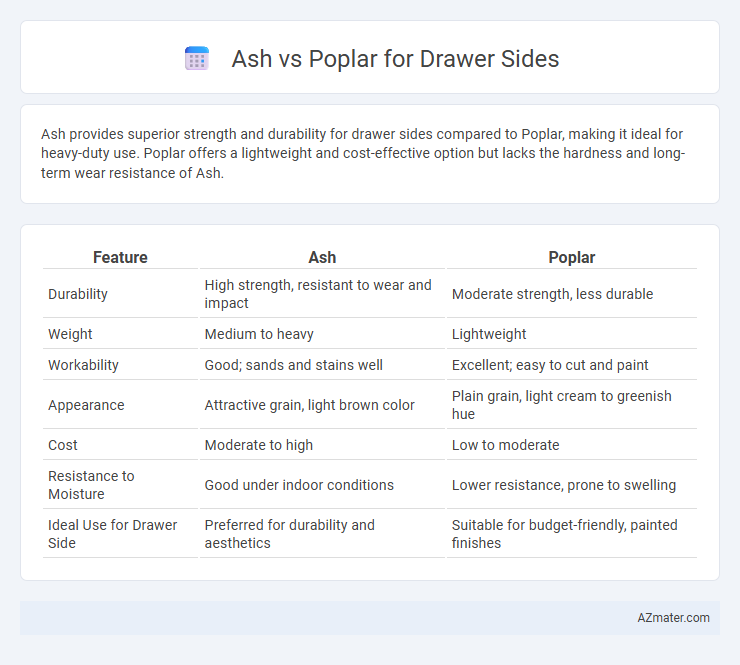Ash provides superior strength and durability for drawer sides compared to Poplar, making it ideal for heavy-duty use. Poplar offers a lightweight and cost-effective option but lacks the hardness and long-term wear resistance of Ash.
Table of Comparison
| Feature | Ash | Poplar |
|---|---|---|
| Durability | High strength, resistant to wear and impact | Moderate strength, less durable |
| Weight | Medium to heavy | Lightweight |
| Workability | Good; sands and stains well | Excellent; easy to cut and paint |
| Appearance | Attractive grain, light brown color | Plain grain, light cream to greenish hue |
| Cost | Moderate to high | Low to moderate |
| Resistance to Moisture | Good under indoor conditions | Lower resistance, prone to swelling |
| Ideal Use for Drawer Side | Preferred for durability and aesthetics | Suitable for budget-friendly, painted finishes |
Introduction to Ash and Poplar as Drawer Side Materials
Ash and poplar are popular choices for drawer sides due to their distinct wood properties. Ash offers exceptional strength and resistance to wear, making it ideal for heavy-use drawers that require durability. Poplar is lightweight and easy to work with, providing a smooth surface for finishing while remaining cost-effective for budget-conscious furniture projects.
Wood Grain and Appearance: Ash vs Poplar
Ash wood features a distinctive, straight grain pattern with a coarse texture, offering a light to medium brown color that enriches drawer sides with a natural, rustic appeal. Poplar shows a more subdued grain, often straight but sometimes wavy, with a smoother texture and a pale, creamy white to yellow-green hue ideal for painted finishes. The pronounced grain of ash emphasizes its natural wood character, while poplar provides a cleaner, more uniform look preferred in contemporary furniture designs.
Workability: Cutting, Shaping, and Machining
Ash offers excellent workability for drawer sides, with easy cutting, shaping, and machining due to its open grain and consistent texture, making it ideal for intricate designs. Poplar, while softer and easier to machine, can sometimes produce a less smooth surface requiring additional finishing, but it excels in rapid cutting and shaping for simple, functional drawers. Both woods handle standard woodworking tools well, though ash provides greater durability and resistance to wear in long-term use.
Durability and Strength Comparison
Ash wood exhibits exceptional durability and strength, making it an ideal choice for drawer sides that require long-lasting support and resistance to wear. Poplar, while easier to work with and more affordable, is softer and less durable, potentially leading to quicker wear and damage under heavy use. For drawer sides demanding higher strength and longevity, ash outperforms poplar due to its superior hardness and resistance to dents and impact.
Weight Differences in Drawer Construction
Ash wood is significantly lighter than poplar, with an average density of 0.60 g/cm3 compared to poplar's 0.40 g/cm3, influencing the overall weight of drawer construction. Choosing ash for drawer sides results in sturdier, more durable drawers but increases the total weight, which may affect ease of use and installation. Poplar's lighter weight minimizes strain on drawer slides and cabinetry but may compromise long-term durability under heavy load conditions.
Cost and Availability of Ash and Poplar
Ash wood is generally more expensive than poplar due to its durability and attractive grain, making it a premium choice for drawer sides. Poplar is widely available and more affordable, often favored for budget-conscious projects and painted finishes. Both woods are readily obtainable in North American markets, but poplar's abundance ensures lower costs and easier sourcing compared to ash.
Finishing Options: Staining and Painting
Ash wood offers excellent stain absorption, allowing for a wide range of rich, natural finishes that highlight its prominent grain patterns, making it ideal for drawer sides with a rustic or traditional look. Poplar, with its fine, even texture, provides a smooth surface that takes paint exceptionally well, resulting in a uniform and vibrant finish perfect for modern or colorful cabinetry. Both woods can be sealed or primed effectively; however, poplar's lighter color tends to show paint colors more accurately, while ash's grain may influence the final tone when stained.
Environmental Impact and Sustainability
Ash wood offers a sustainable option for drawer sides due to its fast growth rate and renewable harvesting practices, minimizing deforestation impact. Poplar, known for its rapid growth and adaptability, also provides an eco-friendly alternative, often sourced from managed plantations that support forest regeneration. Both woods exhibit low VOC emissions and biodegradability, contributing to reduced environmental footprint in furniture manufacturing.
Suitability for Different Drawer Applications
Ash offers excellent strength and shock resistance, making it ideal for heavy-use drawers such as tool chests or kitchen storage where durability is crucial. Poplar, being softer and more lightweight, suits decorative or light-duty drawers like bedroom dressers or office organizers where ease of machining and smooth finishes are preferred. Selecting between ash and poplar depends on drawer load requirements, wear resistance needed, and aesthetic preferences for drawer sides.
Conclusion: Which Wood is Right for Your Drawer Sides?
Ash offers superior strength and flexibility, making it ideal for drawer sides that endure frequent use and heavy loads. Poplar, while softer and easier to work with, is better suited for lightweight or decorative drawers due to its lower durability. Choose Ash for long-lasting, robust drawer construction and Poplar for cost-effective, easily finished projects with minimal wear.

Infographic: Ash vs Poplar for Drawer Side
 azmater.com
azmater.com